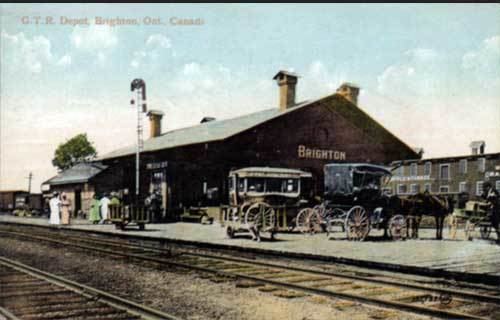Type railway museum Phone +1 613-475-0379 | Province Ontario | |
 | ||
Established 1857 (1857) (station)1995 (1995) (museum) Location 60 Maplewood Avenue, Brighton Key holdings former railway station, locomotive and cars Collections rail equipment and memorabilia Owner Ralph and Eugenia Bangay Address 60 Maplewood Ave, Brighton, ON K0K 1K0, Canada Similar Proctor House Museum, Proctor Park Conserva, Presqu'ile Provincial Park, Western Vancouver Island Ind, Alberta Central Railway | ||
The Memory Junction Railway Museum preserves a collection of railway memorabilia in Brighton, Ontario's former Grand Trunk Railway station, which opened in 1857 and served intercity rail passengers until the 1960s.
Contents
History
Tiny Brighton is on the Toronto-Montréal mainlines of both the Canadian National and Canadian Pacific Railway, which run side-by-side through the village. It once had a third railway, the Canadian Northern Railway, whose tracks occupied the Prince Edward County Railway right of way into Trenton, Ontario. At its peak, ten trains daily stopped at one or another of the three local passenger rail stations, all within a few blocks of each other.
Brighton's rail history dates to the October 27, 1856 opening of the Grand Trunk line from Montréal to Toronto. The current-day Maplewood Street was Railroad Street, agriculture was slowly displacing forestry as the primary local industry and communities long reliant on water transport were eagerly awaiting the rails as a means of access to larger markets.
In its heyday, the Brighton GTR station was a group of seven buildings and a stock yard; there was a freight shed, two private coal sheds, a 35 foot (11 m) wooden water tank and large piles of lumber (GTR's steam trains originally burned wood). The station itself is a "Type C" second-class wayside station, much like those still in rail service in Napanee and Port Hope; a single-story building with five door or window arches on the sides and two arches on each end. Most of these were built from limestone to a standard GTR design with a stone chimney on each of four corners; the Brighton station differs from the others in its use of brick. The original chimneys are now gone.
The railway allowed fruit to be canned in Brighton and transported to ocean ports for shipment overseas; it transported Brighton dairy products to market in Toronto and, in summer, brought thousands of passengers to Presqu'ile Provincial Park, which became an Ontario provincial park in 1922. At the time of the outbreak of the Great War in 1914, an era when there were only fifty motorcars in the village, a second railway came to town: the Canadian Pacific Railway. A fledgling third national railway, the Canadian Northern, completed a line from Quebec to British Columbia in 1915.
CNoR was bankrupt by the end of the war, a third carrier in a saturated market, and was merged by the federal government into what is now Canadian National. CN built a short-lived CNoR Brighton station in 1920, only to abandon it after Grand Trunk's ill-fated attempt to expand westward left it bankrupt in 1922 and part of CNR by 1923. Much of the CNoR infrastructure was duplicative of CN's Grand Trunk line and was abandoned; passenger service moved to the original 1857 Brighton station and the 1920 CNoR station was eventually demolished.
The first efforts to pave the 1817-era stagecoach York Road as a Provincial Highway came near the end of the Great War; by 1964, most of that road - the main street of southeastern Ontario - had been bypassed by construction of a four-lane freeway, Ontario Highway 401. Rail passenger numbers had peaked near the time of World War II and were soon in freefall. Brighton's tiny 1857 passenger rail station was abandoned and boarded up a few years after the freeway came to town, sitting vacant through the 1970s and 1980s.
While much infrastructure had been removed, the original Brighton station building now survives as a museum and was provincially designated on August 16, 2000 under Part 4 of the Ontario Heritage Act.
Museum
In 1995, Ralph and Eugenia Bangay purchased the long-abandoned Brighton Station from CN for $400 as a place to store a growing collection of Brighton rail memorabilia. They restored the gentlemen's waiting room, express office and agent's room in the old brick station to house hundreds of artefacts, using the ladies' passenger waiting room as a souvenir shop.
A 1906 Grand Trunk 2-8-0 steam locomotive (#2534), relocated from Zwick's Park in nearby Belleville, occupies pride of place alongside two box cars (one from 1913), a flat car, three cabooses (including one from 1929) and a 1898 velocipede (a handcar used by repair workers to travel along the tracks). The Murrow Building, which served before 1920 as a distribution point for Ford motorcars destined for dealers from Bowmanville to Gananoque, houses additional memorabilia. The site also includes an 1880s Hops Barn and artefacts ranging from Coca-Cola once bottled in Brighton to Morse code equipment.
The busy CN and CP mainlines still run side-by-side beside the museum, but the countless Via Rail trains carrying passengers from Montreal and Ottawa to Toronto do not stop.
